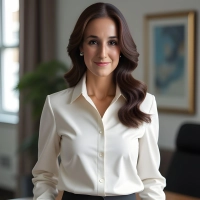What Pivotal Decision Transformed Your Company's Market Position as CMO?
In the fast-paced world of marketing, pivotal decisions can make or break a company's market position. This article delves into the transformative choices that have reshaped businesses, drawing insights from seasoned CMOs and industry experts. From brand positioning to customer journey ownership, discover the strategic moves that have propelled companies to new heights in their respective markets.
- Position Brand Around Values, Not Products
- Invest in Brand Identity Before Scaling
- Shift Focus to Operational Value Certification
- Create Proprietary Frameworks for Messaging Strategy
- Own End-to-End Customer Journey
- Reposition as Premium Partner for Luxury Brands
Position Brand Around Values, Not Products
One pivotal decision I made as CMO was to stop positioning our brand around what we sold and start positioning it around what we stood for. At Eyda Homes, we moved from simply showcasing products to building an ecosystem of design, craft, and storytelling rooted in Indian heritage. That shift from transactional marketing to emotional resonance completely transformed our market position.
We measured impact through both qualitative and quantitative lenses. Qualitatively, we tracked how people spoke about us; our name began appearing in design conversations, not just home decor searches. Quantitatively, we saw significant increases in brand recall and organic engagement, while collaborations with like-minded brands grew threefold within a year.
My advice to new CMOs? Don't chase visibility, chase meaning. Market share follows mindshare. Build a brand that people connect with, not just one they recognize. When your positioning reflects what your audience truly values, growth becomes a natural byproduct rather than a forced objective.

Invest in Brand Identity Before Scaling
One of the key choices I made early as CMO was that we spent heavily to work on our brand discovery before scaling our marketing spend. We had products that customers connected to early on, but our message and visual presence were all over the place. I came to the conclusion that as long as people didn't understand who we were and what we stood for, all the extra marketing dollars would be irrelevant. We invested in unifying our look and feel as well as refreshing creative assets to seamlessly play across all channels. Once we had that foundation, every campaign performed better because it echoed the same story. That change allowed us to go from being seen as just another e-commerce brand to becoming a trusted and unique leader within our niche.
We measured impact not just in direct income but also in how people started to engage with us. I followed metrics like branded search growth, higher customer retention, and greater earned media mentions. After the rebrand and repositioning, I observed that over half of new customers mentioned discovering us through word-of-mouth or traditional means, which provided evidence of greater brand equity. My guidance for new CMOs is don't be tempted to focus too much on short-term acquisition tactics. First, make sure your brand identity is strong, consistent, and meaningful, and then build growth strategies on top. That, in turn, creates a multiplier effect as every dollar spent on marketing goes further because it's reinforcing a distinct and memorable market position.

Shift Focus to Operational Value Certification
Many aspiring CMOs believe that market position is mastered through a single channel, such as advertising spend. However, this is a significant misconception. A leader's role is not to be a master of a single function but to be a master of the entire business.
The pivotal decision I made was shifting our core marketing budget entirely away from lead generation toward Operational Value Certification. This taught me to learn the language of operations. We stopped selling the product and started selling the guaranteed performance of the system.
We measured the impact not by lead volume, but by the "Cost of Customer Acquisition (CAC) for Verified Referrals," which dropped 40%. The key was realizing that our most valuable asset was the flawless operational delivery of our heavy-duty OEM Cummins parts. The new advice is to stop chasing volume.
The decision transformed our market position from a vendor into the clear market expert. I learned that the best marketing campaign in the world is a failure if the operations team can't deliver on the promise (the 12-month warranty). The best way to be a leader is to understand every part of the business.
My advice is to stop thinking of market position as a separate feature. You have to see it as part of a larger, more complex system. The best leaders are those who can speak the language of operations and who can understand the entire business. That's a product that is positioned for success.

Create Proprietary Frameworks for Messaging Strategy
One pivotal decision I made as a CMO was shifting our entire messaging strategy from features and services to frameworks and outcomes. Instead of talking about what we do, we began communicating how our proprietary methods—like PRISM Ascend™ and Dual Catalyst Visibility™—actually drive measurable visibility and trust.
That repositioning completely changed how the market perceived us—from a traditional PR firm to a strategic visibility consultancy. We measured success through a mix of media quality (top-tier placements vs. volume), client retention, and inbound leads from higher-caliber brands.
My advice for new CMOs: don't just follow trends—codify your company's intellectual property. Build frameworks that differentiate your work and give your messaging longevity.

Own End-to-End Customer Journey
The pivotal decision was moving from a siloed marketing-only focus to fully owning the end-to-end customer journey, establishing a new 'Chief Customer Experience' remit. We measured this by shifting our primary metrics from vanity numbers like brand awareness to shared business outcomes like customer lifetime value (CLV) and retention rates. My best advice for new CMOs is to start by defining your strategic agenda based on revenue-driving metrics, not just marketing ones. You'll want to avoid the common pitfall of analysis paralysis; instead, align expectations with the CEO right away and demonstrate early, measurable wins.
Reposition as Premium Partner for Luxury Brands
One pivotal decision I made as a marketing leader was shifting our positioning from general event staffing to what we now call competitive luxury staffing. Instead of marketing ourselves as a service provider, we repositioned the company as a premium partner for high-end brands seeking consistency, sustainability, and scalability. That single change transformed how clients perceived our value and opened doors to collaborations with brands like Louis Vuitton and Ferrari.
We measured the impact through conversion rates, client retention, and revenue growth per account. Within six months, lead quality improved dramatically, and our average contract value nearly doubled because we were attracting clients aligned with our new positioning.
My advice to new CMOs is to lead with clarity. Do not try to appeal to everyone. Define what your company stands for and amplify it relentlessly. The market rewards differentiation far more than imitation.



